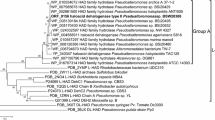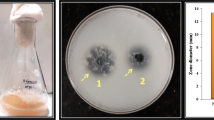Abstract
2-haloacid dehalogenases are enzymes that are capable of degrading 2-haloacid compounds. These enzymes are produced by bacteria, but so far they have only been purified and characterized from terrestrial bacteria. The present study describes the purification and characterization of 2-haloacid dehalogenase from the marine bacterium Pseudomonas stutzeri DEH130. P. Stutzeri DEH130 contained two kinds of 2-haloacid dehalogenase (designated as Dehalogenase I and Dehalogenase II) as detected in the crude cell extract after ammonium sulfate fractionation. Both enzymes appeared to exhibit stereo-specificity with respect to substrate. Dehalogenase I was a 109.9-kDa enzyme that preferentially utilized D-2-chloropropropionate and had optimum activity at pH 7.5. Dehalogenase II, which preferentially utilized L-2-chloropropionate, was further purified by ion-exchange chromatography and gel filtration. Purified Dehalogenase II appeared to be a dimeric enzyme with a subunit of 26.0-kDa. It had maximum activity at pH 10.0 and a temperature of 40 °C. Its activity was not inhibited by DTT and EDTA, but strongly inhibited by Cu2+, Zn2+, and Co2+. The K m and V max for L-2-chloropropionate were 0.3 mM and 23.8 μmol/min/mg, respectively. Its substrate specificity was limited to short chain mono-substituted 2-halocarboxylic acids, with no activity detected toward fluoropropionate and monoiodoacetate. This is the first report on the purification and characterization of 2-haloacid dehalogenase from a marine bacterium.





Similar content being viewed by others
References
Asmara W, Murdiyatmo U, Baines AJ, Bull AT, Hardman DJ (1993) Protein engineering of the 2-haloacid halidohydrolase IVA from Pseudomonas cepacia MBA4. Biochem J 292:69–74
Bachas-Daunert PG, Law SA, Wei Y (2009) Characterization of a Recombinant Thermostable Dehalogenase Isolated from the Hot Spring Thermophile Sulfolobus tokodaii. Appl Biochem Biotech 159(2):382–393
Barth PT, Bolton L, Thomson JC (1992) Cloning and partial sequencing of an operon encoding two Pseudomonas putida haloalkanoate dehalogenases of opposite stereospecificity. J Bacteriol 174(8):2612–2619
Bradford MM (1976) A rapid and sensitive method for the quantitation of microgram quantities of protein utilizing the principle of protein-dye binding. Anal Biochem 72(1):248–254
Busquets A, Peña A, Gomila M, Bosch R, Nogales B, García-Valdés E, Lalucat J, Bennasar A (2012) Genome sequence of Pseudomonas stutzeri strain JM300 (DSM 10701), a soil isolate and model organism for natural transformation. J Bacteriol 194(19):5477–5478
Cairns SS, Cornish A, Cooper RA (1996) Cloning, sequencing and expression in Escherichia coli of two Rhizobium sp. genes encoding haloalkanoate dehalogenases of opposite stereospecificity. Eur J Biochem 235(3):744–749
Diez A, Prieto MI, Alvarez MJ, Bautista JM, Puyet A, Pertierra G (1996) Purification and properties of a high-affinity L-2-haloacid dehalogenase from Azotobacter sp. strain RC26. Lett Appl Microbiol 23(5):279–282
Fetzner S, Lingens F (1994) Bacterial dehalogenases: biochemistry, genetics, and biotechnological applications. Microbiol Rev 58(4):641–685
Goldman P, Milne G, Keister DB (1968) Carbon-halogen bond cleavage III. Studies on bacterial halidohydrolases. J Biol Chem 243(2):428–434
Hill KE, Marchesi JR, Weightman AJ (1999) Investigation of two evolutionarily unrelated halocarboxylic acid dehalogenase gene families. J Bacteriol 181(8):2535–2547
Hisano T, Hata Y, Fujii T, Liu JQ, Kurihara T, Esaki N, Soda K (1996) Crystal structure of L-2-haloacid dehalogenase from Pseudomonas sp YL. An alpha/beta hydrolase structure that is different from the alpha/beta hydrolase fold. J Biol Chem 271(34):20322–20330
Huang J, Xin Y, Cao X, Zhang W (2011a) Phylogenetic diversity and characterization of 2-haloacid degrading bacteria from the marine sponge Hymeniacidon perlevis. World J Microbiol Biotechnol 27(8):1787–1794
Huang J, Xin Y, Zhang W (2011b) Isolation, characterization and identification of a Paracoccus sp. 2-haloacid-degrading bacterium from the marine sponge Hymeniacidon perlevis. J Basic Microbiol 51(3):318–324
Jones DHA, Barth PT, Byrom D, Thomas CM (1992) Nucleotide sequence of the structural gene encoding a 2-haloalkanoic acid dehalogenase of Pseudomonas putida strain AJ1 and purification of the encoded protein. J Gen Microbiol 138:675–683
Klages U, Krauss S, Lingens F (1983) 2-Haloacid dehalogenase from a 4-chlorobenzoate-degrading Pseudomonas species CBS3. Hoppe Seylers Z Physiol Chem 364(5):529–535
Kurihara T, Esaki N, Soda K (2000) Bacterial 2-haloacid dehalogenases: structures and reaction mechanisms. J Mol Catal B Enzym 10(1–3):57–65
Leigh J, Skinner A, Cooper R (1988) Partial purification, stereospecificity and stoichiometry of three dehalogenases from a Rhizobium species. FEMS Microbiol Lett 49(3):353–356
Lin CJ, Yang LR, Xu G, Wu JP (2011) Enhancement of haloacetate dehalogenase production by strain mutation and condition optimization. Biothechnol Bioprocess Eng 16:923–929
Little M, Wiliams P (1971) A bacterial halidohydrolase: its purification, some properties and its modification by specific amino acid reagents. Eur J Biochem 21(1):99–109
Liu JQ, Kurihara T, Hasan A, Nardi-Dei V, Koshikawa H, Esaki N, Soda K (1994) Purification and characterization of thermostable and nonthermostable 2-haloacid dehalogenases with different stereospecificities from Pseudomonas sp. strain YL. Appl Environ Microbiol 60(7):2389–2393
Morsberger FM, Muller R, Otto MK, Lingens F, Kulbe KD (1991) Purification and characterization of 2-halocarboxylic acid dehalogenase II from Pseudomonas spec. CBS3. Biol Chem Hoppe Seyler 372(10):915–922
Motosugi K, Esaki N, Soda K (1982a) Purification and properties of 2-halo acid dehalogenase from Pseudomonas putida. Agric Bio chem 46(3):837–838
Motosugi K, Esaki N, Soda K (1982b) Purification and properties of a new enzyme, DL-2-haloacid dehalogenase, from Pseudomonas sp. J Bacteriol 150(2):522–527
Motosugi K, Motosugi K, Esaki N, Soda K (1984) Enzymatic preparation of D- and L-lactic acid from racemic 2-chloropropionic acid. Biotechnol Bioeng 26(7):805–806
Nardi-Dei V, Kurihara T, Okamura T, Liu JQ, Koshikawa H, Ozaki H, Terashima Y, Esaki N, Soda K (1994) Comparative studies of genes encoding thermostable L-2-halo acid dehalogenase from Pseudomonas sp. strain YL, other dehalogenases, and two related hypothetical proteins from Escherichia coli. Appl Environ Microbiol 60(9):3375–3380
Peña A, Busquets A, Gomila M, Bosch R, Nogales B, García-Valdés E, Lalucat J, Bennasar A (2012) Draft genome of Pseudomonas stutzeri strain ZoBell (CCUG 16156), a marine isolate and model organism for denitrification studies. J Bacteriol 194(5):1277–1278
Sarkar S, Pramanik A, Mitra A, Mukherjee J (2010) Bioprocessing data for the production of marine enzymes. Mar Drugs 8(4):1323–1372
Schneider B, Muller R, Frank R, Lingens F (1991) Complete nucleotide sequences and comparison of the structural genes of two 2-haloalkanoic acid dehalogenases from Pseudomonas sp. strain CBS3. J Bacteriol 173(4):1530–1535
Schneider B, Muller R, Frank R, Lingens F (1993) Site-directed mutagenesis of the 2-haloalkanoic acid dehalogenase I gene from Pseudomonas sp. strain CBS3 and its effect on catalytic activity. Biol Chem Hoppe Seyler 374(7):489–496
Smith JM, Harrison K, Colby J (1990) Purification and characterization of D-2-haloacid dehalogenase from Pseudomonas putida strain AJ1/23. J Gen Microbiol 136:881–886
Soda K, Kurihara T, Liu JQ, NardiDei V, Park C, Miyagi M, Tsunasawa S, Esaki N (1996) Bacterial 2-haloacid dehalogenases: structures and catalytic properties. Pure Appl Chem 68(11):2097–2103
Swanson PE (1999) Dehalogenases applied to industrial-scale biocatalysis. Curr Opin Biotechnol 10(4):365–369
Tsang JSH, Sallis PJ, Bull AT, Hardman DJ (1988) A monobromoacetate dehalogenase from Pseudomonas cepacia MBA4. Arch Microbiol 150(5):441–446
Van der Ploeg J, Van Hall G, Janssen DB (1991) Characterization of the haloacid dehalogenase from Xanthobacter autotrophicus GJ10 and sequencing of the dhlB gene. J Bacteriol 173(24):7925–7933
Weightman AJ, Weightman AL, Slater JH (1982) Stereospecificity of 2-monochloropropionate dehalogenation by the Two dehalogenases of pseudomonas putida pp 3: evidence for two different dehalogenation mechanisms. J Gen Microbiol 128:1755–1762
Zhang C, Kim SK (2010) Research and application of marine microbial enzymes: status and prospects. Mar Drugs 8(6):1920–1934
Acknowledgments
This work was financially supported by National Basic Research Program of China (973 program, Grant No. 2009CB724700), the Hundred Talent Program of the Chinese Academy of Sciences (A1097), the Knowledge Innovation Program of the Chinese Academy of Sciences (Grant No.KSCX2-YW-G-073).
Author information
Authors and Affiliations
Corresponding author
Rights and permissions
About this article
Cite this article
Zhang, J., Cao, X., Xin, Y. et al. Purification and characterization of a dehalogenase from Pseudomonas stutzeri DEH130 isolated from the marine sponge Hymeniacidon perlevis . World J Microbiol Biotechnol 29, 1791–1799 (2013). https://doi.org/10.1007/s11274-013-1340-2
Received:
Accepted:
Published:
Issue Date:
DOI: https://doi.org/10.1007/s11274-013-1340-2




